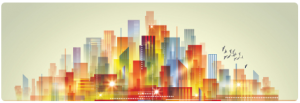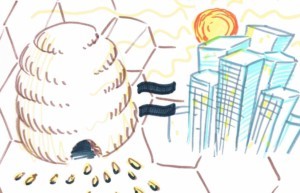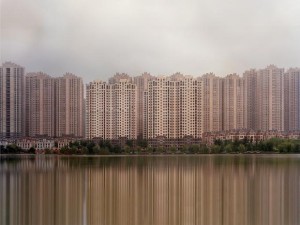Marilyn Hamilton's Blog, page 51
September 1, 2016
Neo-Civics for a Neo-City?
It looks like Neo-Cities are on the drawing boards – and even before Investor Boards. I wonder if the investors will consider similar aspects of investing in cities as they do in entrepreneurial start-ups? Especially the importance of the organizational team?

In entrepreneurial ventures the quality of the people generally outweighs the most clever of ideas or the most unusual patents.
I suggest the same ought to be true of Neo-Cities. But how will that be done? Will there be an application process? A recruitment team?
What criteria will they use to choose the initial citizens?
Will the criteria hold the same seeds of disaster that many an intentional community has sown?
How will the recruiters separate their own biases from the needs of the Neo-City?
How will the designers build in the appropriate form of governance? Will they design the first stage and then expect neo-politicians to take over the subsequent stages of developing governance – like strata corporations?
Will the state become involved in setting standard for Neo-Cities?
Will Neo-Cities exempt themselves from state interference through economic separation of banking and transactional exchanges?
Does a Neo-City need a neo-civics? Would that evolve out of Integral City’s 4 Voices and 4 Roles???
Might the Integral City 4 Voices provide the stem-cells for such a neo-civics?
This blog is part of a series on Neo-Cities:
Are Neo-Cities Human Hives
What are Neo-Cities Forgetting?
August 31, 2016
What are Neo-Cities Forgetting?
When I think about the Neo-Cities of Lifsitz and Musk I get quite excited. They seem to be really designed with the external requirements of the human hive in mind.

But I also get really agitated. Because I wonder if they have considered any of the internal requirements of the human hive.
Like the known fact that humans go through a developmental cycle. How have they built into the design that we all start out at a basic stage and must learn our way through a series of developmental stages?
Do the designers recognize verticality in themselves? Have they made allowances for continuous learning and the need/opportunity for the city to change?
What happens if assumptions about the city’s environment (both internal and external) are drastically altered by events not under the designer’s control (e.g. natural disasters, or man-made invasions).
How do Neo-Cities respond to the need to defend themselves from external invaders? How do they defend themselves against envy, greed, power-plays?
What is the right relationship of Neo-Cities to other Neo-Cities and Traditional, Modern, Post-Modern Cities?
This blog is part of a series on Neo-Cities:
Are Neo-Cities Human Hives
August 30, 2016
Are Neo-Cities Human Hives?
I was intrigued to read recently about the Neo-Cities imagined by Yury Lifsitz. The concept seems very aligned to designing human hives.

Bee – Human Hive – Tijmen Brozius
By all accounts they design in many elements that give the city beauty, fitness to the environment and alignment with the intentions of the people who will potentially live there.
However, have they actually been designed WITH the people who will live there? Even when those people are imagined to be an elite group who will choose to live in a city that enables them to co-exist with others who share interests.
Or are they just the doodles of the designers who imagine how the ideal human hive can be built because the designers know best?
But are the designers merely projecting their own intentions and expectations onto their designs?
Do the investors and developers like Elon Musk resume expect the Neo-Cities they are apparently commissioning to exist apart from the Traditional, Modern and Post-Modern cities that already exist? Here are some questions I would love to ask these stakeholders:
Is a Neo-City just the leading edge of cities of the future? Do we expect them to emerge as the logical next step for cities?
The Neo-City assumes that it is possible to create a specialized habitat for humans with select interests. But I have some questions that exorcise my soul:
How will Neo-Cities learn from the Masdar or Dubai effect – where construction and maintenance workers cannot afford to live there?
How do Neo-Cities administer themselves democratically?
How do the voices of non-elite workers and residents equate with the elite?
Do Neo-Cities risk developing caste systems (internally or in comparison to external cities)?
August 29, 2016
ZomBees versus Zombie Cities

ZomBees?
The Divine certainly has a sense of humour. Otherwise, I might not notice that in one week I read an article on the Zombie Cities in China – where the human hive has been built without a human to occupy them (yet) … and …
An article on ZomBees – where the bodies of honeybees are invaded by the philon fly which lays its eggs on the bee and thereby disemboweling it as its larvae mutate and later transmute into flies.
What is more horrifying? Zombie cities mothballed for the people who will bring them to life? Considering people can simply be injected into the built forms and expected to thrive (but who might not even survive?)
Or ZomBees whose bodies have been parasitized by another living form who depend on the bee’s life- generating cycle of survival to regenerate?
It could be that my horror of the Zombie cities is magnified by my suspicion that the rest of the world who supplied materials and energy have been used like ZomBees to “hatch” the Chinese cities?
Is it any comfort to believe that the Chinese have forgotten the vital ingredients of the human developmental cycles in consciousness, and culture? Chinese Zombie Cities need much more than the material appearance of people to populate them – they need human souls and spirit to bring them alive.
This is part of a series of blogs on China’s empty cities that triggered a series of Integral City thought capsules and thought experiments. See also:
A City Without People is not a City
Building a [City] Bridge Without Walking On It.
China Why Not House the Refugees in your Empty New Cities?
August 26, 2016
Burtynsky and Caemerrer Photographs Haunt Cities
The hauntingly beautiful photographs by Caemerrer of China’s new – but empty – cities reminded me of Burtynsky’s photographs of industrial over-reach.

Burtynsky Shipyard
Burtynsky has recorded the disasters of the Modern industrial revolution in the form of photographs that display the patterns and textures of its very demise.
But even in the midst of technical and mechanical horrors, Burtynsky has the habit of injecting the evidence of man’s humanity.
The horror of the picture file of China’s new Cities is that the hand of man is evident in the built form but absent from its occupation.
One photographed the haunting beauty of disaster, the other the disaster of beautiful but soulless haunts.
This is part of a series of blogs on China’s empty cities triggers a series of Integral City thought capsules and thought experiments. See also:
A City Without People is not a City
Building a [City] Bridge Without Walking On It.
August 24, 2016
China Why Not House the Refugees in your Empty New Cities?
The sight of China’s empty cities prompted colleague, Anne-Marie Voorhoeve to ask – “Why not house the refugees here?”

What a logical question – that provides a solution in one country (China) to a problem in another country (Syria).
Even if China were a democratic country, like the USA, housing refugees is a problématique that does not lie easy on the body politic.
And finding new housing in the often housing-poor West is a challenge even without an influx of refugees from the Middle East.
The question of “Why not house the refugees in China’s empty cities?”, presupposes a willingness, openness, values-set, compassion and charity that are generally part of the mindsets of northern Europe and North America.
But even those countries are balking at the challenges of importing Middle-East cultures that seem hostile to indigenous cultures of Europe and North America. The invasion of refugees with all their needs, traumas, expectations and “differences” has prompted right wing extremists in USA, France, UK and elsewhere to lash out against them.
And those factions balk, generally because their countries have admitted refugees and immigrants for many decades while resentments have been festering. (Some like Canada and the USA have been expressly built from mosaics and melting-pots of in-migrating cultures).
But when was the last time that you heard of China admitting any such peoples in peril? Who offered to help the hurricane victims of the Philippines? Or the boat people of Vietnam? Or the tsunami victims of southeast Asia? Or the starving of Ethiopia?
China has long nursed a history of isolationism and even as 20th and 21st century trade has opened its doors to the rest of the world’s inflow of financial exchange for its outflow of cheap goods, China does not have a reputation for assisting the less fortunate.
Expanding the Circles of Care from Self to Others to Cities to the Planet of Cities (Integral City’s Master Code) is an evolutionary trajectory that the state of China is only just beginning. China is still in a Self-centric mode of existence. And it may even fear the Other to such an extent that opening the empty cities to refugees would seem pure anathema to China’s sense of Self and its security.
I wonder what and how the rest of the world might offer a resource to China for shifting to a larger Circle of Care?? Might the trade for our energy and mineral resources (that have gone into the building of these new cities), in the future be linked to a condition of re-investment on behalf of the world’s greatest needs? How can we ask that the “sacred” soil and new cities of China be shared with refugees who bring skills, intelligence and experience that would bring an entirely renewable form of energy to China’s new cities?
This is part of a series of blogs on China’s empty cities triggers a series of Integral City thought capsules and thought experiments. See also:
A City Without People is not a City
Building a [City] Bridge Without Walking On It.
August 23, 2016
Building a [City] Bridge Without Walking on It
China has built a string of new cities, ostensibly to house the rural poor who will be moved into cities in the next decade.

Photo by Caemmerer
Not waiting for those people to over-populate and add to the slums of existing cities, China has taken a preventative measure of building whole new cities to house them.
But can you take the man/woman out of the country without taking the country out of the man/woman?
Where are the plans for people to be acclimatized to a whole new way of life, with new relationships, technology, work, transportation, financial transactions – not to mention the basics of daily life – accessing water, food, clothing, furniture?
This pre-built city approach appears to be a form of modern day colonization, where the state in China will just transport people where they don’t want them into where the state thinks they should be. To the modern eye, this appears to be a gift of beneficence – but to the Integral City eye, such forced migrations will never work, without the commensurate attention and resources supplied for cultural and social integration.
That cultural and social integration begins with the intention and attention shared by the individuals, families, work groups, education, health and community services who populate cities. They should be the co-contributors, co-designers and inhabitants who start with the desire to move; the connections that matter; and the plan to make it happen. When consciousness and culture are willing participants in the design of the city, people will “build the bridge by walking on it (1)”.
When someone else builds the bridge without attention to those who will walk on it, it may never cross the river in the right place.
I for one am extremely suspicious of the ready made “bridges” (aka new cities) where it appears you can just span the river and expect people to cross and pay the bridge toll!!
Notes:
(1) An expression coined by Paulo Freire about his work in developing countries.
This is part of a series of blogs on China’s empty cities triggers a series of Integral City thought capsules and thought experiments. See also:
August 21, 2016
A City Without People is not a City
A series of articles on China’s empty cities triggers a series of Integral City thought capsules and thought experiments.

China Ghost City , Photographed by Caemmerer
According to a Wired article, China has built 100’s of cities to house millions of people over the next 20 years. Today they stand empty. No people in the apartments. No workers in the workplaces. No vehicles at the intersections. No eyes on the street.
The photographs of the cities are hauntingly dream-like – but they remind me of Burtinsky’s horrifyingly beautiful renditions of industrial pollution.
While America built houses with a sub-prime mortgage scheme that encouraged runaway development and entrapped ordinary workers with financial overheads that became intolerable and too onerous to bear, the state of China has invested in not just houses but whole built cities – now warehoused, waiting for inhabitants.
Which investment scheme has more merit? The one that sucks the breath out of people’s souls or the one that builds “brick lungs” without souls?
Integral City would argue that the built city of bricks and mortar is a container – but incomplete. When the design and purpose of the city container is built without the participation of the inhabitants, it lacks the native intelligences of Culture and Consciousness. It is an exoskeleton without soul.
The Chinese may have hired the best architects, but did they study the history of “housing projects” and people relocations elsewhere? Do they have plans to cope with the hopelessness, addictions and disorientation of the Inuit who were relocated in Canada? Or do they have expectations to cope with the inner city dis-ease and lawlessness that characterizes Toronto’s Regent’s Park or Chicago’s south side (where Jane Jacob’s predicted that the lack of “eyes on the street” would create conditions lacking safety and security). Or do they know how they will prevent the unemployment and clannish enclaves that became the Gorbals in Glasgow?
July 20, 2016
What Part of the Master Code is Not Working for the Human Hive?
Paris, San Bernardino, Brussels, Ferguson, Nice, Orlando, Dallas, Lahore, Baton Rouge, Istanbul.

The world’s cities seem threatened from within and without.
When Integral City sponsored the Online Webinar 2012, we learned the five major threats that all cities faced were: climate, energy, water, food and finance. Since then we have added a sixth threat that trumps them all – and that is culture.
The culture of our cities is being pierced, torn apart and shredded by fear, anger and deep angst.
Culture is the collective expression of values, worldviews and belief systems that holds each city together. It is woven one thread at a time by each person, family, group, street, neighborhood and community until the city’s cultural cloth of warp and woof becomes substantial enough and resilient enough for the weavers to walk across without thought to its existence. Culture in a city is largely invisible but utterly vital to the living dynamic of its wellbeing and existence.
Culture arises from practice of what we call the Master Code:
Take care of yourself
Take care of each other
Take care of this place
Take care of this planet.
The Master Code has an evolutionary thrust to it that naturally emerges hierarchies of complexity. Enabling care of self, others, place and planet is a universal code that transcends and ought to include a multiplicity of belief systems. Practice of the Master Code at each level of complexity weaves the tensile strength to practice at the next level of complexity. In other words, taking care of one self enables taking care of others: taking are of others enables taking care of place; taking care of place enables taking care of planet.
But the shock and horror of terrorist acts, racial injustices and police murders in not just one city, but in many cities around the world are undeniable symptoms that some fundamental dis-ease is afflicting our human hives. Our cities are losing their capacity to function with the Master Code.
Why? It may be that we have failed to realize that the Master Code has an involutionary thrust to it as a natural complement to the evolutionary thrust. Each city has emerged from the life conditions supplied by the planet at its distinctive geological location. The life conditions of the city create the context for the capacity for families and groups to care for one another; and the capacity of families to care creates the primal hearth for caring for individuals who learn first in the family to care for themselves.
The terrible irony and truth of the Master Code is that its evolutionary practice depends utterly on its involutionary sustainability and resilience. The reverse orders of enabling care in the city depends on the institutions our city cultures have created to keep us safe, secure and supported so that we can care – at any level of complexity.
(For those who follow my study of the honey bee, consider the evolutionary and involutionary qualities of their double sustainability loop. The hive is sustained by the “cultural and economic” engine that produces 20 kg of honey per year for internal hive survival, but also is sustained externally because the bees pollinate the surrounding eco-region so that energy sources are renewed for next year. This double sustainability loop is essentially evolutionary and involutionary like the Master Code.)
When Citizen and Civil Society Voices of the city perceive that care has departed from the Civic Management and Business Voices (including but not limited to police, justice, emergency response, health, education and the economy), they sense and believe that the Master Code that maintains order in the human hive has deserted them. They can no longer relate to a system that they perceive denies them rights to work, relate, act and think in ways that sustain them. When this perception operates in enough people in the city (my guess would be 10 to 15% of the citizens) then the fabric of culture from which all the Voices of the city have evolved Is torn apart.
Evolution then becomes replaced by revolution – it looks like acts of terror, military coups, street fights and guerrilla warfare. Care becomes hatred expressed as racial slurs, heinous threats and socially mediated anger. The evolutionary thrust of the Master Code disintegrates and demagoguery, despotism and disintegration ensue.
The involutionary thrust of the Master Code retreats to the planetary basics of climate, energy, water and soil, with food and finance in scarce supply. For the evolutionary thrust of the Master Code has enabled the conversion of all the resources that are embedded in our planetary roots (climate, energy, water, soil, and biology) into Place Caring and Place Making Capacities that have produced our human hives. Evolutionary capacities advance like unfurled prayer mats because they are re-sourced by involution; involutionary resources retreat when evolutionary prayer mats disappear.
What is not working in our human hives? It may be our failure to comprehend that in order to sustain our capacities for caring for each other and the city – at any and all levels of complexity – we are dependent on the planet and cites that have cared for us. The invisible cultural fabric that we have taken for granted is now haplessly visible as it has been blasted to shreds under our feet, over our heads and around our homes.
Will we now have to abandon the looms we have used to weave the cultural prayer mats of our human hives and pick up the tools for hooking rugs from rags and jute cloth to patch them back together?
July 1, 2016
You Wanted Me Back!

by Marilyn Hamilton
Tribute to my MLA , Darryl Plecas, Parliamentary Secretary for Seniors BC
Keynote Speaker at Canada Day Lunch
Canada geese fly across blue sky
Leaders (like MLA’s) taking turns
Northern lights as bright and iridescent as our multi-
Culturism
C2C2C2SKY2C2SHINING C
Song for Canada.
Unity
Freedom
Healing
Generations
Incense to this place
Touch our hearts
149th birthday celebration.
Dominion
Our country unique
Beautiful natural environment
Celebrate people
Like YOU.
Honour Order of Abbotsford Recipients
Build strong community
Promise justice and character
Inspired, listened, acted
Building a complete community.
I am news junkie.
Canada was a British colony
May these gates never be closed
2-Way Trade
Comfortable as neighbours.
Canada is a HUGE country.
1/10th United States
… they say …
Residing in World Class Cities
-81 degrees not including wind-chill??!!
If you are in a fight you want
Canadians on your side.
Reliable partners
Highway of heroes
Rescuers
In our darkest hours Canada has been with US
Operation Yellow Ribbon
Close, productive, peaceful.
We share our continent.
Let no man put asunder!
Flag waving, uncharacteristic display of patriotism
Too much geography!
We live as far south as possible
Unarmed American with benefit of health care!!??
World needs MORE Canada.
Harp music in wheat fields …
YOU WANTED ME BACK!!??
Even though saying wrong thing?
To 3 other former mayors?
Getting initiative off the ground to
Recognize seniors for what they offer
Provide opportunity
Seniors tell stories
Tell young people
Instill value systems
Capture expertise
Volunteering 20 years
Create platform for opportunity
To teach others
As a pilot for 3 years
Coordinate all this
Changing our thinking
About seniors
Recognize all seniors can do for everyone else
Finding ways to be respectful to people with disabilities
Connected
Give every senior an iPad (like Japan).
Do NOT ask me to record anything –
I hope he doesn’t turn it off 
Holding people by the hand
Work with them for 4 months – incredibly comfortable
Plugged into the wide world – infotainment can be shallow
But connecting can give
Greater ability in a nanosecond
Have a doctor in a second.
Next year is the BIG ONE.
1 – 5 – 0. 150. 150th.
You’ve all been here for half of them
Reflect where we’ve been –
CANADA IS
Because what Canada has done for others
What can we do
NOW
To make life better
For those who follow us?
Stories
Lay Foundation
Of CARE – on a continuum
Better at Home or
Home that is just like home
Giving absolutely amazing incredible level of CARE!!
Phone me first to find out
How well you’ll live
Have a wonderful quality of life.
You made my life better – you wanted me back!
This Land is My Land
This Land is Our Land.
Have a blessed Canada Day!!
Marilyn Hamilton's Blog
- Marilyn Hamilton's profile
- 3 followers



